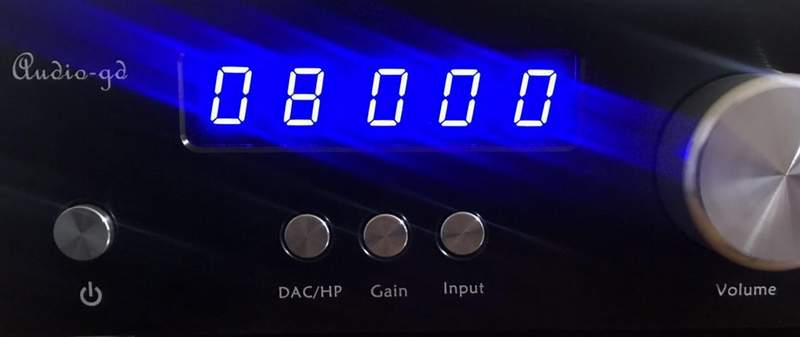Function introduce :
The DAC can setting the digital
process functions on front plate to change the sound flavors, without open the unit .

How to active the
digital setting mode:
The "OUT" and "Input"
buttons has dual functions.
While the input between input 5
and input 6, the "OUT" button can select the output mode between
"H" (Headphone output) and "P" (Preamp output) .
While the input is between 1 to
4, the "OUT" button become dual functions.
In case, push the "OUT"
button one time, the left first display flashing around 3 seconds,
in term if the "OUT" button has not push again, the output mode
change either "H" or "P".
If the "OUT" button push
again while the left first display flashing, the unit go into the
digital setting mode.
OUT button :
While the
unit had went into the digital setting mode, the one digit display
will blink for active the function setting , push the "Input" button
can change function .
While the display blink, push "OUT"
again , the right next one digit display will blink for setting .
Left 1st display : Oversampling
"O" for select oversampling,
"N" for select NOS mode.
Left 2nd display : OS and NOS modes
While OS
setting on "O" mean the DAC working under oversampling
mode, lower number OS modes sound became warmer
and smoother. Or depend on your sense .
Mode "0" : class
technology NOS mode.
Mode "2" : 2X oversampling.
Mode "4" : 4X oversampling .
Mode "8" : 8X oversampling.
While OS setting on "N" mean
the DAC working under NOS mode, it has one mode now, it is the full
new NOS configure design.
Left 3rd display :
(Simulate
SAA7220 +TDA1541A sound) :
Active
(1) : Simulate SAA7220 +TDA1541A, digital attenuation low to -55DB,
was -130DB. Bitwide low to 16bit , was 24 bit. While active this
function, I are advice setting to OS2 or OS4 mode. But infact, this
function can working with any setting mode.
Left 4th. display : (Syn version for correct
HDMI data, Asy version for Dith)
Syn version : If the HDMI input had noise, distortion or some
samplings no sound, user can setting the 1st number ON (1) or OFF
(0) to fixed the issue. In default is OFF (0) .
Asy version : Active
(1) or Disable (0) dither for all inputs.
Left 5th. display : Display
Active (1) the display
auto dark, the display will become dark in around 10 seconds after
stop operate any buttons . Disable (0) the display auto dark, the display light
always.
"Input" button:
While
the display non blink, for select the input sources.
While the display blink, for
setting the digital process functions.
HDMI
definitions : (Compatible with PS audio standard)
Pin 1 : SDATA -
Pin 2 : GND
Pin 3 : SDATA +
Pin 4 : SCLK +
Pin 5 : GND
Pin 6 : SCLK -
Pin 7 : LRCK -
Pin 8 : GND
Pin 9 : LRCK +
Pin 10: NC
Pin 11: GND
Pin 12: NC
Pin 13: NC
Pin 14: NC
Pin 15: NC
Pin 16: NC
Pin 17: GND
Pin 18: NC
Pin 19: NC
R28 don't need MLCK input . Even the
source has MLCK output but has not effect .
|


